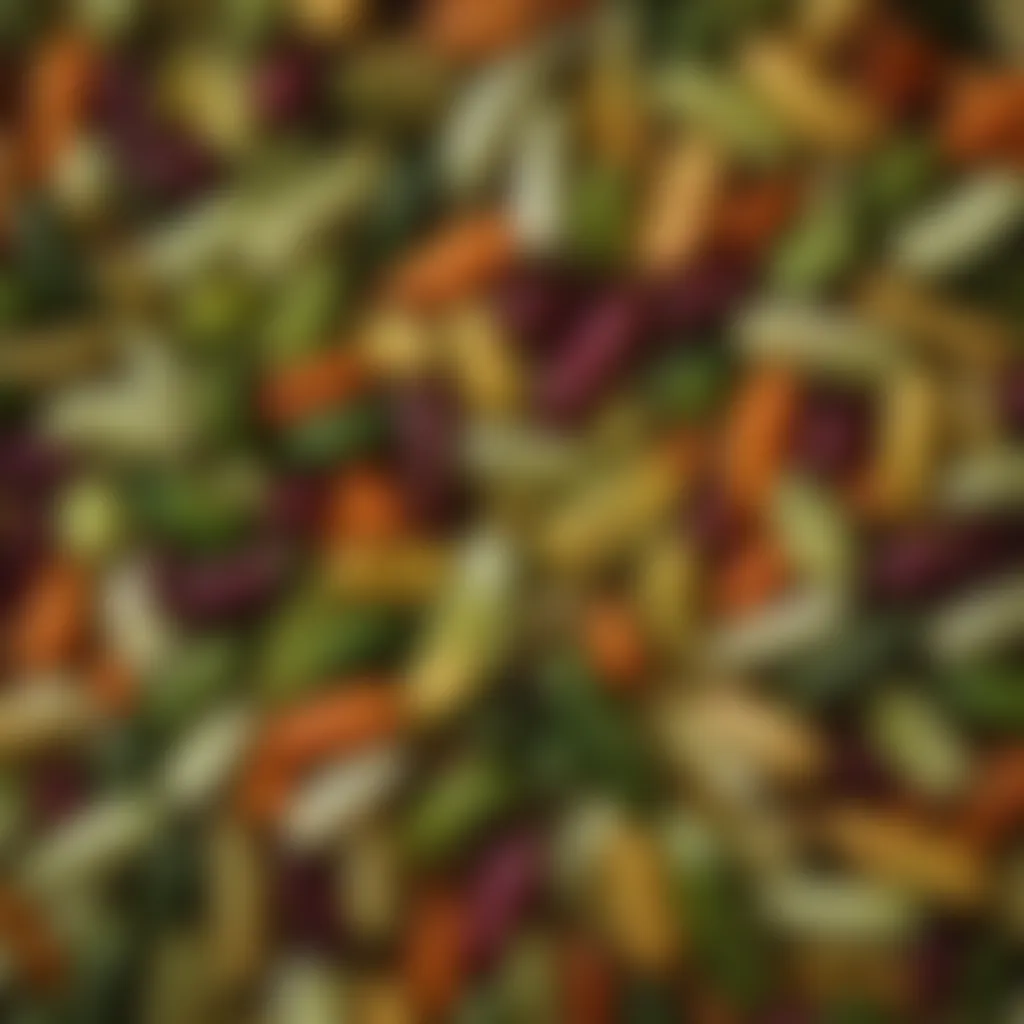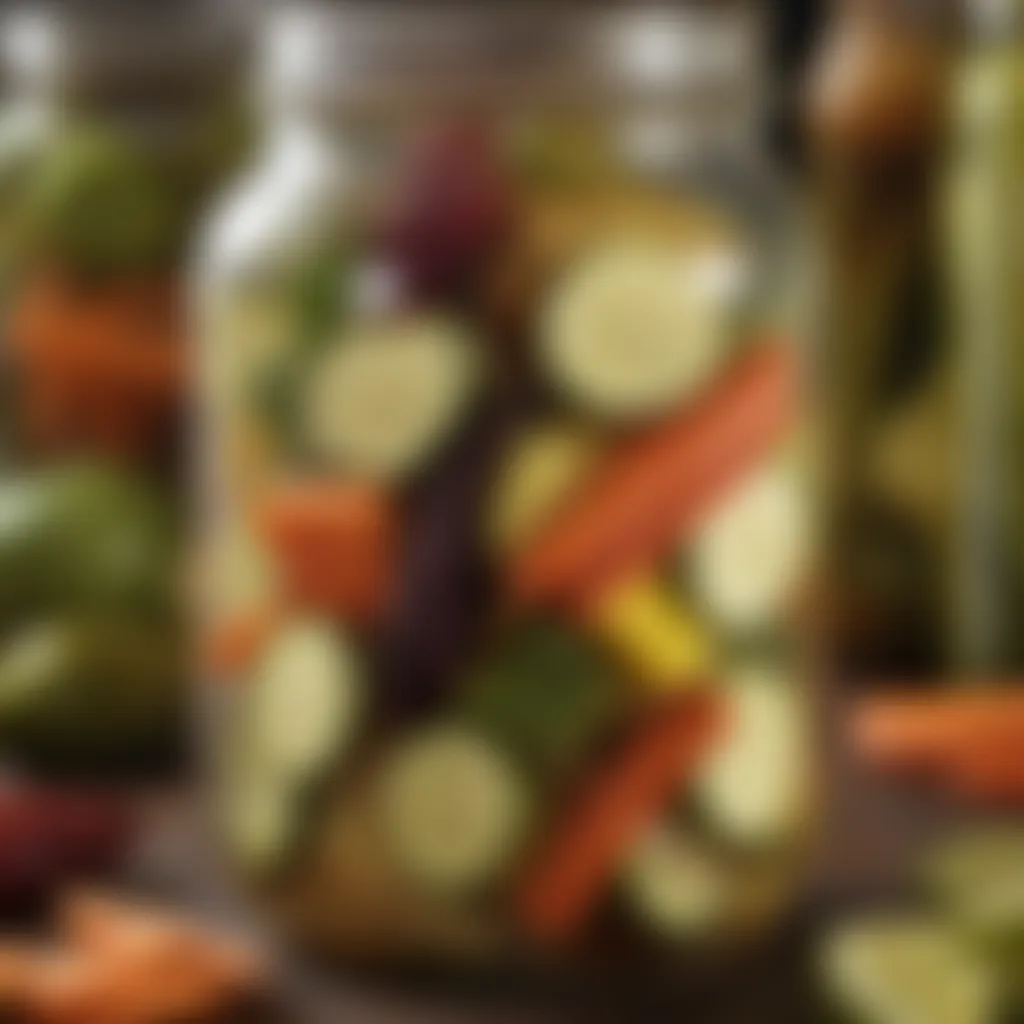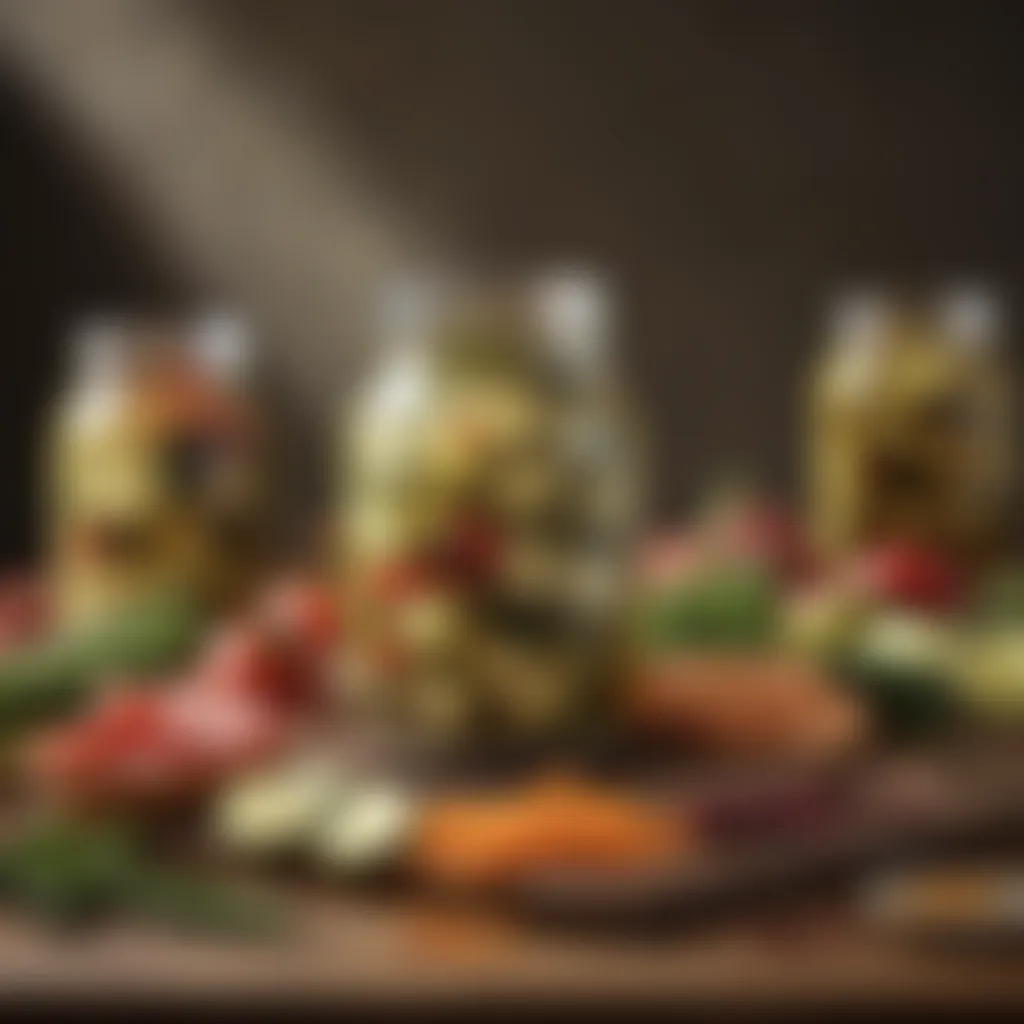Exploring Unconventional Pickling Practices


Intro
Pickling is a time-honored culinary tradition that preserves food through brining or fermentation. While many are familiar with classic pickles made from cucumbers, the world of pickling offers a plethora of unconventional and truly weird interpretations. This article ventures into the depths of unconventional pickling practices, exploring the intriguing origins, ingredients, and cultural meanings behind these unique creations.
In recent years, a surge of creativity has transformed the pickle landscape. Many cooks and home preservationists are experimenting with various ingredients and methodologies, leading to the emergence of unusual yet delightful pickles. Understanding these diverse practices not only enriches our culinary repertoire but also sheds light on the historical and social contexts that have shaped eating habits across cultures.
Let’s embark on this exploration, starting with the essential ingredients needed to create these unconventional pickles.
Prolusion to Weird Pickles
Pickling is more than just a culinary technique; it is an art form that captures various cultural heritages and flavors. In this exploration of weird pickles, we aim to unveil the deeper layers of this fascinating practice. The world of pickling is not limited to traditional cucumbers and brine. Instead, it extends to unconventional ingredients and methods that challenge our perception of what pickles can be. By understanding these unconventional practices, we can enrich our culinary experiences and discover new tastes.
Defining Weirdness in Pickling
Weirdness in pickling can be defined by the ingredients, techniques, and cultural contexts that differ from the norm. Traditional pickles usually utilize cucumbers, vinegar, and straightforward spices. In contrast, weird pickles may include unexpected vegetables or fruits, such as carrots or watermelon rinds. The use of exotic spices or flavoring agents also contributes to the definition of weirdness.
What makes these pickles particularly interesting is their ability to surprise the palate. For example, pickled radishes, which some may never consider, can offer a spicy and refreshing twist to the pickling experience. Weirdness, therefore, transcends mere oddity and becomes a celebration of culinary creativity.
Historical Context of Pickling
To fully appreciate the diversity of pickling practices today, we must explore its historical context. Pickling dates back thousands of years, with evidence suggesting that ancient civilizations used it as a preservation method to extend the shelf life of foods. The process involved fermenting foods in seasoned brine or vinegar, which helped prevent spoilage.
Across various cultures, pickling adopted unique characteristics based on available ingredients and local customs. For instance, Indian Achar incorporates various spices, while Korean Kimchi is heavily rooted in fermentation techniques that include chili, garlic, and ginger. The historical significance of these pickle types cannot be overstated, as they often reflect the food culture and agricultural practices of their origins.
"Pickling is not just about preservation; it’s a reflection of culture, creativity, and culinary history."
Understanding the historical backdrop of pickling allows us to see how it evolved and adapted over time, leading to the weird pickles we are fortunate to explore today. This inquiry into the past equips us with insights necessary for appreciating the nuances found in contemporary pickling trends.
The Science of Pickling
Understanding the science behind pickling is essential for anyone curious about creating unique and flavorful preserves. The process of pickling is not just a culinary practice, but also a fascinating interplay of biological and chemical reactions. These reactions determine the texture, taste, and preservation of pickled items. This section explores key elements such as microbial fermentation and the role of acidity, laying a foundation for why unconventional choices in pickling can yield remarkable results.
Microbial Fermentation
Microbial fermentation is a cornerstone of many pickling processes. When vegetables or fruits are submerged in a brine or left to ferment in their natural juices, specific microorganisms come into play. Lactic acid bacteria, for example, thrive in low-oxygen environments and convert sugars into lactic acid. This process accomplishes several significant outcomes:
- Preservation: The acid produced by fermentation lowers the pH, making conditions inhospitable for spoilage bacteria.
- Flavor Development: The fermentation contributes to complex flavor profiles, transforming plain vegetables into richly flavored products.
- Texture Changes: Fermentation modifies the texture of the pickled items, often resulting in a pleasing crunch.
However, the type of fermentation can vary. For instance, a quick pickle using vinegar has different microbial involvement compared to a long-term lacto-fermentation. Each method brings its own nuances and benefits.
Role of Acidity in Flavors
Acidity is another vital element in the pickling process. It not only preserves food, but also shapes its overall taste. The most common acids used in pickling are vinegar and natural lactic acid, both of which offer distinct flavors:
- Vinegar: Regular high-acidity vinegar, like distilled white or apple cider vinegar, is conventional in quick pickling. Its sharpness can be potent, leading to a tangy profile that often dominates the taste, making it popular for cucumber pickles.
- Lactic Acid: This is produced during fermentation. Its milder and slightly sweet flavor can enhance rather than overpower the taste of pickled goods, allowing the original flavor of the ingredients to shine.
"The quality of the acid, whether from vinegar or fermentation, can elevate the entire pickling experience—both in taste and in health benefits."
The balance between the ingredient’s natural flavors and the acidity is crucial. Too much acidity can mask flavors, while too little may result in spoilage. Understanding this balance empowers pickle enthusiasts to experiment with unconventional ingredients without compromising preservation or flavor quality.


Unusual Ingredients in Pickling
Unconventional pickles are unique not only because of their methods but largely due to the ingredients utilized. Exploring unusual ingredients in pickling yields diverse flavors and textures. This section considers vegetables and fruits that step beyond the common cucumber, broadening the scope of pickling practices. The importance of discovering these ingredients lies in their ability to enhance both culinary creativity and nutritional value, while offering an opportunity for experimentation in the kitchen.
Vegetables Beyond Cucumbers
Carrots
Carrots stand out as a popular choice in unconventional pickling. Their natural sweetness complements pickling brines well. This sweetness balances out the acidity in pickles and introduces a distinct flavor profile. Carrots also retain their crunchiness, which is a delightful texture in a pickle. As they absorb the brine, their vibrant orange color becomes more pronounced, making pickled carrots visually appealing.
However, there are considerations. Carrots have a firm texture, which requires proper slicing for even pickling. If cut too thickly, they may not achieve the desired taste. Nonetheless, their health benefits, including high vitamin A content, make them a compelling choice for home picklers.
Zucchini
Zucchini is another vegetable that often goes overlooked in pickling discussions. Its mild and adaptable flavor allows it to absorb various brines well. Additionally, zucchini's high-water content can dilute flavors, which may be advantageous for those preferring a light pickle experience.
The unique feature of zucchini is its versatile application in dishes. Pickled zucchini can enhance salads, sandwiches, or serve as a side dish. However, it has a tendency to become soft if over-pickled, which is a safeguard for novices to consider. When pickling, timely removal from the brine helps to preserve the desired texture and flavor balance.
Radishes
Radishes bring a spicy kick to pickling, making them an exciting inclusion. Their bright color and crispness contribute not only to flavor but also to aesthetic appeal in jars. Pickled radishes can add a zesty surprise to any dish, whether served with tacos or salads.
The quick pickling process of radishes is particularly beneficial. They can be ready in a matter of hours, making them a great option for spontaneous pickling projects. However, the spiciness can become overwhelming for those unaccustomed to it, so it may be wise to experiment with various brine recipes to moderate the heat.
Fruits as Candidates for Pickling
Watermelon Rinds
Watermelon rinds often find themselves discarded, but they are a uniquely edible part of the fruit. Pickling watermelon rinds transforms this underappreciated ingredient into a crunchy, slightly sweet condiment. Its versatility allows it to be paired with savory dishes or enjoyed on its own.
The special aspect of pickled watermelon rinds lies in their ability to absorb flavors from the brine, making them a repository for spices and seasonings. They can bring a refreshing contrast to heavier meals. However, watermelon rinds must be prepared properly—after removing the outer green skin, the inner rind should be cut into appropriate sizes to ensure even pickling.
Pickled Peaches
Pickled peaches offer a delightful melding of sweet and savory. Their juiciness combined with a hint of tang from the vinegar creates a complex flavor. This contrasts elegantly with savory dishes and can elevate simple recipes to gourmet status.
The unique feature of pickled peaches is their potential to enhance both desserts and savory recipes alike. Yet, they do require careful consideration of when to pickle—timing is critical to ensure they are at peak ripeness. Under- or overripe peaches can lead to undesirable textures in the final product, thus patience is essential.
Beetroot
Beetroot is another popular choice among creative picklers. Its earthy flavor and striking color make it an attractive option. Pickled beetroot often finds its place in salads or on sandwiches, adding a touch of sweetness and vibrant color.
One of the benefits of pickling beetroot is its ability to stay firm after processing, maintaining the integrity of the ingredient. Minimal effort is needed to prepare beetroot, which adds to its appeal. However, the key characteristic to manage is its strong flavor, which may overwhelm other components in a dish if not balanced wisely with acid or spice.
Cultural Perspectives on Pickling
Understanding cultural perspectives on pickling is critical in uncovering the multifaceted significance of this culinary practice. Picking is not just a method of food preservation; it is a vibrant expression of identity, tradition, and innovation across various societies. Each region has its own flavors, ingredients, and stories that enrich the practice of pickling. Through these perspectives, we can appreciate how pickles reflect local resources, societal values, and historical influences.
For instance, the pickling methods embraced by different cultures often tie back to specific economic needs, climatic conditions, and available ingredients. This element of resourcefulness can reveal much about a community’s adaptability and creativity. Additionally, nostalgic elements play a role, linking pickled foods with family gatherings and cultural celebrations. An exploration of cultural perspectives allows one to draw connections between food, identity, and cultural heritage.


Pickling Traditions Worldwide
Korean Kimchi
Korean kimchi is perhaps one of the most recognized forms of pickling globally. Its core component — fermented vegetables, typically napa cabbage along with radishes and various spices — illustrates a deep-seated tradition. A key characteristic of kimchi is the fermentation process, which not only preserves the vegetables but also enhances their flavors. This process contributes to the overall topic of weird pickles by demonstrating the complex flavors achievable through fermentation. As a staple in Korean cuisine, kimchi exemplifies how pickling can enhance nutrition while providing a rich taste.
One unique feature of kimchi is its versatility; it can be served with a variety of dishes or enjoyed on its own. However, as a fermented food, it may cause digestive concerns for some individuals. Understanding kimchi broadens the conversation about pickled foods, highlighting health benefits and culinary applications.
Indian Achar
Indian achar represents another interesting aspect of pickling traditions. Achar includes a diverse range of pickled fruits and vegetables, prepared with various spices, oils, and acids like vinegar or lemon juice. A key characteristic of Indian achar is its bold and intense flavors, often driven by regional spice mixes. This contributes beneficially to the article as it showcases how different regional spices alter not only taste but also nutritional profiles.
The unique feature of achar is its use of seasonal ingredients, making it adaptable to local climates and crop availability. This means that the ingredients can vary widely, showcasing the richness of regional diversity. However, the high spice content can be overwhelming for some and might limit its acceptance in certain cuisines. Achar thus serves as a valuable example of how pickling reflects local agricultural practices and cultural tastes.
Japanese Tsukemono
Japanese tsukemono, or pickled vegetables, is another prime instance of pickling traditions. Commonly made with a range of vegetables, tsukemono employs various pickling techniques, including salt-curing and vinegar-based methods. The key characteristic of tsukemono is the balance of flavors, which often ranges from sweet to savory and tart. This complexity contributes to the broader conversation of weird pickles by providing insight into the harmony of flavors achieved through different pickling methods.
A unique feature of tsukemono is its presentation as a side dish in traditional Japanese meals, enhancing both flavor and color on the plate. This visual appeal means tsukemono has a significant role in culinary aesthetics. However, tsukemono typically uses ingredients that may not be widely accessible in all regions, which can limit its popularity.
Regional Variations in Ingredients
The ingredients used in pickling often vary greatly across regions. Each culture emphasizes locally available produce, which shapes the distinctive characteristics of their pickled foods. This section will explore how these variations influence flavor profiles and methods, enhancing our understanding of pickling as not merely a technique, but a cultural journey.
Modern Trends in Pickling
Modern trends in pickling reflect a growing curiosity about flavors and health. As consumers seek unique culinary experiences, pickling emerges as a creative avenue for experimentation. This section will outline key elements and benefits of the current pickling landscape, emphasizing both the artisanal approach and the influx of celebrity influence.
Craft and Artisanal Pickling
Craft and artisanal pickling have gained traction over recent years. Home cooks and small-scale producers prioritize quality and originality over mass production. This trend emphasizes using local, organic ingredients. There is a focus on seasonality, which enhances flavor and freshness. The approach allows for the inclusion of unusual combinations like pickled blueberries or radishes marinated with ginger.
Many new artisanal brands are popping up, which often feature unique recipes that reflect local tastes and traditions. They also promote sustainability, choosing eco-friendly materials for packaging. Importantly, some picklers create workshops where individuals can learn the craft. This initiative not only boosts local engagement but also helps preserve cultural practices surrounding pickling.
Artisanal pickling has also opened avenues for innovation in texture and flavor. Fermented pickles nourish gut health, showcasing another layer of benefits. Consumers are increasingly aware of these health implications, making them more inclined to choose crafted products over industrial ones. Interested individuals may explore local markets to taste these new offerings or even attempt DIY projects at home.
Celebrity Chefs and Weird Pickles
Celebrity chefs have notably influenced the contemporary landscape of pickling. They showcase weird and unique pickle recipes in their cookbooks and shows, firmly placing these practices in mainstream conversation. This coverage tends to embolden home cooks to try making unconventional pickles. Some create unexpected pairings like pickled garlic with strawberries, defying traditional flavors.
Additionally, social media amplifies visibility for these strange pickles. Platforms enable chefs to share creative processes easily. Users can follow trends, replicate recipes, and even share their experiences. For example, chefs like David Chang or Alex Guarnaschelli have introduced audiences to pickling techniques involving unconventional ingredients. Their unique approaches enhance the exploration of textures and flavors, providing a vibrant framework for culinary experimentation.
The creativity brought forth by celebrity chefs has opened a dialogue about pickling, inspiring many to explore beyond cucumbers.
In summary, the modern trends in pickling unite craft and celebrity influence, leading to an experience enriched by flavors and community engagement. The combination of artisanal methods and celebrity endorsement serves not only as a revival of an age-old preservation technique but as a pathway toward culinary innovation. This evolution in pickling deserves consideration as it reshapes how we view food preservation.
Health Implications of Weird Pickles
Understanding the health implications of weird pickles is crucial in today's culinary landscape. These pickles are not just about creative flavor; they also come with a variety of health benefits and potential risks. As housewives increasingly explore unconventional pickling methods, being informed about these aspects becomes essential for making healthy choices.


Nutritional Benefits
Weird pickles, made from an array of unusual ingredients, can offer surprising nutritional advantages. Some key benefits include:
- Probiotics: Many pickling processes involve fermentation, which can introduce probiotics into the diet. Probiotics are beneficial bacteria that support gut health, potentially improving digestion and boosting the immune system.
- Vitamins and Minerals: Vegetables and fruits rich in vitamins can retain some of their nutritional value even after pickling. For instance, pickled carrots can still provide Vitamin A, while pickled beets can offer folate and manganese.
- Low-Calorie Snack: Weird pickles often serve as a low-calorie, flavorful snack. They can satisfy salty cravings without adding significant calories to the diet, making them a desirable option for health-conscious eaters.
It is important to note that the specific health benefits can vary based on ingredients and preparation methods. Therefore, experimenting with different components and recipes can yield additional health rewards.
Potential Risks and Considerations
While exploring weird pickles can be exciting, some potential risks should be acknowledged:
- High Sodium Content: Many pickling recipes utilize brine, often high in salt. Excessive sodium intake can contribute to health issues like hypertension and cardiovascular disease. It is wise to monitor sodium levels, particularly for those with existing health conditions.
- Allergens: Unconventional ingredients might introduce allergens that some individuals may need to avoid. For example, pickling certain fruits might involve the use of spices or additives that could provoke reactions in sensitive people. Careful ingredient selection is vital.
- Quality Control: As with any home-preserving method, ensuring proper hygiene and preservation techniques is crucial. Failure to follow safe practices can lead to foodborne illnesses or spoilage.
"Understanding the balance between health benefits and potential risks is essential in making informed decisions about weird pickles."
By staying informed on these health implications, housewives can enhance their culinary experiences while prioritizing their family's health.
The Future of Pickling
The world of pickling is evolving. The future promises not only bold flavors but also a shift towards more sustainable practices. As people become more concerned about their health and the environment, pickling is likely to adapt. This article section will dive into how innovations in flavors and techniques are propelling pickling forward, and how sustainability is becoming a priority.
Innovations in Flavors and Techniques
The search for unique flavor profiles is driving innovation in the pickling process. Beyond traditional ingredients, modern picklers experiment with unexpected additions. Consider the use of spices like sumac, or unusual liquids such as tea or craft beer. These elements create distinctive tastes that challenge conventional notions of pickles.
Fermentation techniques have advanced as well. Many are now exploring wild fermentation, where natural yeasts in the environment contribute to the pickling process. This method can produce complex flavors, often leading to surprises in every batch.
Furthermore, accessibility of new technologies also enhances experimentation. Home picklers can find specialized equipment, such as vacuum sealers, which can alter the pickling process. These innovations allow for more control over flavor intensity and texture.
"The modern pickler is not just preserving food; they are creating a culinary experience."
As consumers become more adventurous, the market demands these innovative offerings. This trend suggests a future where pickling is not merely a method of preservation but a canvas for culinary creativity.
Sustainability in Pickling Practices
Sustainability is becoming a critical concern in food production, and pickling practices are no exception. As awareness of food waste escalates, creative use of ingredients is more important than ever. Utilizing scraps from otherwise discarded vegetables can give life to flavorful pickles. Carrot tops, cabbage cores, and even unused fruit skins can transform into delicious accompaniments. This practice not only helps reduce waste but also saves money.
Moreover, selecting local and seasonal produce supports sustainable agriculture. By sourcing ingredients from local farms, picklers reduce their carbon footprint. Additionally, this can foster community relationships, forging connections between producers and consumers.
In comparison, conventional pickling often relies on mass-produced ingredients. This shift to sustainable practices counters environmental challenges and supports local economies.
Ending
The conclusion serves as a pivotal segment of the exploration into weird pickling practices. It ties together various elements discussed throughout the article, ensuring that the reader leaves with a clearer understanding of why these unconventional pickles matter.
Summary of Findings
In examining the intricacies of weird pickles, several key findings emerged:
- Culinary Variety: The use of unusual ingredients like watermelon rinds and beetroots showcases the diverse nature of pickling. It opens up a multitude of flavor profiles that can elevate any dish.
- Cultural Significance: Across various cultures, pickling serves not only as a preservation method but also as an expression of identity and heritage, reinforcing communal bonds through shared, unique recipes.
- Health Considerations: While unconventional pickling can offer nutritional benefits, such as increased probiotics, it is essential to be aware of potential risks, including high sodium content in certain recipes.
"Weird pickles reflect culinary creativity and the willingness to experiment, proving that food can be both a canvas and a medium of cultural expression."
Closing Thoughts on Culinary Exploration
Engaging with the world of weird pickles invites a journey of culinary exploration. Each brined jar tells a story, blending tradition with individual creativity. The act of pickling, whether for preservation or experimentation, fosters a deeper connection to food, emphasizing the ingredients' origins and uses. As home cooks, we should embrace this adventurous spirit, acknowledging that every unique pickle can inspire new dishes and conversations around the table. Adopting unconventional pickling practices not only expands our culinary repertoire but also serves as a reminder of the rich cultural tapestries that food interweaves. Thus, continuing to explore these oddities will surely enrich our kitchens and broaden our palates.







